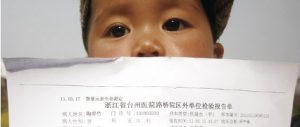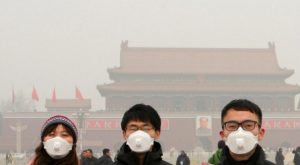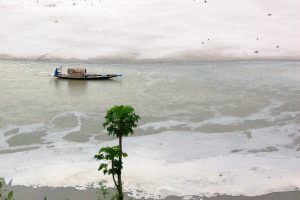The media outrage in Europe and the US over high levels of lead in imports of rice from China was a stark reminder of a much bigger and ongoing problem of lead poisoning in the country.
In a four-year period, between 2006 and 2010, there were 20 major lead pollution incidents across the whole of China. In 2009, there were a total of 178 documented cases of lead pollution.
The blame lies largely with China’s metal refineries, with China suffering the downsides of being a major producer and user of heavy metals.
“China accounts for such a huge proportion of lead production as it has so many battery-making factories – particularly lead-acid batteries, which use large amounts of lead – and lead refineries, and so the extent of lead pollution is much worse than in any other nation,” Natural Resources Defense Council (NRDC) lawyer David Lennett told chinadialogue.
Lead accumulates in the body and can lead to nerve and kidney damage. In children, who are particularly susceptible, it has also been linked to reduced IQ and disruptive behaviour.
“The absorption rate of lead for children is 42%-53%, five time that of adults, but children have only 30% of adults ability to expel lead,” said a microblog post from Qingdao No. 9 People’s Hospital,
“As children often play on the ground, much of the lead absorbed by the children near the smelting plant comes from soil pollution,” explained Lennett, who said that when lead levels in soil reach a certain level, action should be taken to clean it up.
Study finds polluted soil
Lennett said poor management is to blame – regulations are weak, safety standards are lacking, government reactions are slow and legislation is not robust enough.
Since 2008 the NRDC has been working with the Institute of Environmental Law at Zhongnan University of Finance and Economics, the Public Health School at Huazhong University of Technology’s Tongji College of Medicine, the Yunnan Environmental Monitoring Centre and Yunnan Centre for Disease Control, on a study of lead pollution from a mine and smelting plant in north-east Yunnan.
The 30-month study found that lead levels in soil from school grounds, classrooms and fields downwind breached national quality standards by a factor of 2 to 7.
The NRDC’s report pointed out the area has no system for managing the health risks from lead pollution, and the environmental and health authorities rarely work together or share information – there is an almost complete lack of any system to evaluate health risks and intervene.
The failings in preventing and dealing with lead pollution were clear: emission controls were inadequate or not implemented; there was no adequate buffer zone between the smelter plant and residential areas; monitoring was limited and patchy; and emissions were effectively going unmonitored. Serious soil pollution was going untreated.
The China Association of the Environmental Protection Industry recently established a Heavy Metal Pollution and Soil Restoration Committee. The dozens of environmental companies coming together to create this platform indicates that there is an ever-increasing market for those able to help deal with heavy metal pollution.
However, the committee found that “work is still continuing on how to apply laboratory technologies and research findings at scale in the field,” and that “there is a lack of standards and safeguards, and weak provision of scaled commercial services.”
Guo Jianqiang, deputy head of the China International Engineering Consulting Corporation, said that “overall China is weak in soil treatment and restoration and lacks viable technologies.”
In 2006 the Ministry of Health issued a trial version of guidelines for categorising and dealing with lead poisoning in children. The same year the State Environmental Protection Agency and the Ministry of Land and Resources launched a billion yuan survey of soil pollution – the results of which are still unpublished.
But Chen Nengchang, a researcher at the Guangzhou Institute of Geochemistry, said that “currently China’s management of lead emissions is focused on large firms, there is little action on soil pollution.” Also, China lacks a single soil restoration standard, so there are no technical references to apply.
Lack of compensation to victims
Major lead pollution incidents continue to cause problems. Eighty-one polluting companies were closed down within a five day period in Guiyang in Hunan in 2009; while in Fengxiang in Shaanxi 841 children were found to be suffering from lead poisoning, with 174 of those cases being moderate or severe; in Jiyuan in Henan, 30 firms were shut down after over 1,000 children were found to be suffering from lead poisoning.
Similar incidents have occurred over the last three years in Shaoguan, Zijin and Renhua, all in Guangdong province, south China. In Renhua, 37 cases of child lead poisoning were identified in 2012 – a figure the Yangcheng Evening News now puts at 64.
Zheng Jianwei, a Chongqing lawyer, told chinadialogue that 135 people were exposed to lead pollution during the case of mercury pollution in Yujian, Sichuan province. But they have still received no compensation from government, and families have not been able to afford treatment for their children.
Zheng said that after one villager accidentally discovered he was suffering from lead poisoning, others had themselves tested. Under pressure from the public, the government sent all the local children to Chengdu for testing, and 47 were found to have lead poisoning. Some children had blood lead levels of 400 micrograms per litre, four times the norm.
Treatment was given for a month or two, until lead levels reduced. But villagers did not receive any compensation.
Lennett said the US has gone through similar experiences with lead pollution.
“It was the same in the US in the 1970s. At the end of the decade, the US adopted a new mode of development and over the next 10 years there was a clear improvement.” Perhaps, he said, China can learn from that.
Today the US only has one plant refining lead from ore. The others produce lead from recycled items such as batteries. Those, and some imports from Mexico, meet domestic demand.
Retailers selling lead-acid batteries are also required under law in most states to collect used batteries for recycling.
According to Lennett, such regulatory norms and standards should be put in place as soon as possible in China. But to deal with the more immediate issue, legislation on pollution is needed, “obliging the factories and government to restore and clean up,” he added.






